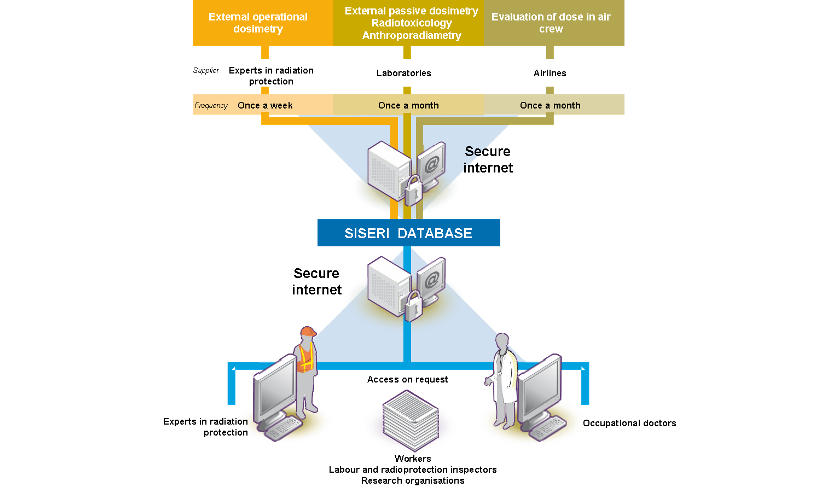About SISERI
An information system for occupational dosimetry registration
The SISERI information system was developed at the request of the Ministry of Labour in order to centralise, verify and preserve all dosimetric data relating to each worker exposed to ionising radiation in France.
The dosimetric data collected in the SISERI system constitute a national register of exposure of individual workers. This system is intended for operational users such as occupational doctors and experts in radiation protection.
Dosimetric data on individuals are made available to these people via the internet, within the limits set by the regulations, with strict access rules so that confidentiality is preserved. This enables them to monitor exposure, to manage exposure of persons in the best way possible and to check that statutory dose limits are being observed.
The monitoring data recorded in SISERI can also be sent to functional users such as labour inspectors and radioprotection inspectors.
Finally, these data may be processed for survey purposes with the aim of optimising radioprotection of workers. They may also be used by researchers for epidemiological studies.

Dosimetric monitoring of workers in France annually concerns more than 350,000 people who are exposed to ionising radiation as part of their work. Each of these workers is monitored by external passive dosimetry with one or more dosimeters suitable for the various types of radiation to which they are exposed. This monitoring is quarterly or monthly. In addition, if there is a risk of exposure of the extremities (hand, wrist etc.), extremity dosimetry is added to this passive whole-body dosimetry.
In situations where the person is working in a controlled zone (average hourly dose rate > 7.5 µSv), he or she also carries an active or operational dosimetry system which provides information about his or her exposure in real time.
Finally, if there is a risk of internal contamination, the worker in monitored by in vitro toxicological measurements or in vivo anthroporadiametric measurements. When there is evidence of internal contamination, the occupational doctor calculates the internal dose.
- External passive dosimetry measurements are carried out by accredited laboratories approved by the Nuclear Safety Authority. There are eight organisations which currently provide dosimetric monitoring of workers and send the results of the external passive dosimetry to SISERI at regular intervals, at least once a month.
- Operational dosimetry is the responsibility of works managers, assisted by experts in radiation protection. Establishments which use operational dosimetry to monitor their own employees or external workers employed on their site send the operational dosimetry results directly to the SISERI system on a weekly basis.
- Internal contamination of workers is monitored at the initiative of the occupational doctor and is carried out by accredited biomedical analysis laboratories approved by the Nuclear Safety Authority. The results of anthroporadiametric tests and/or radiotoxicological analyses must be sent to SISERI. When contamination is found, the internal dose must be calculated by the occupational doctor and this value is recorded in SISERI to provide a cumulative measurement of the worker's effective dose.
- The SISERI system can also manage dosimetry of flight personnel. This dosimetry is calculated by the airlines using SIEVERT software developed by the IRSN and results are sent by the airlines to the SISERI system.
Dosimetric information or exposure measurements are sent by the various data suppliers to the SISERI system via a secure internet access, using a strictly-defined protocol and transmission formats.
Each item of information sent to the SISERI system is linked to a worker by a unique identifier: his or her registration number on the national population register. Each item of dosimetric information includes, in addition to the dose values, the worker's identifier, information relating to his or her work (employer, status etc.) and information relating to the occupational doctor and expert in radiation protection responsible for this worker. Dosimetric data and their sources are kept for every worker registered in the SISERI system, together with their case history. The data may be accumulated to reconstruct the cumulative effective dose over several years or even over the worker's whole life.
In addition to its capability to centralise data on individual monitoring of workers exposed to ionising radiation, the SISERI information system provides occupational doctors and experts in radiation protection with dosimetric information or measurements of exposure of workers via a secure internet access. Access is subject to authorisation and is restricted to the workers for whom the doctors and experts are responsible.
